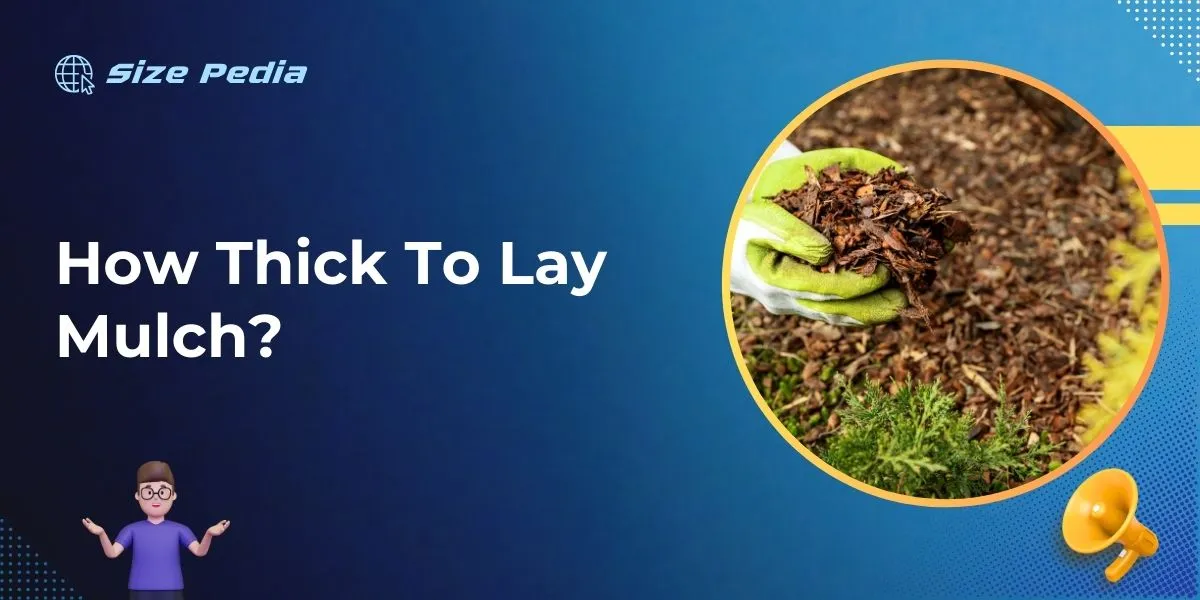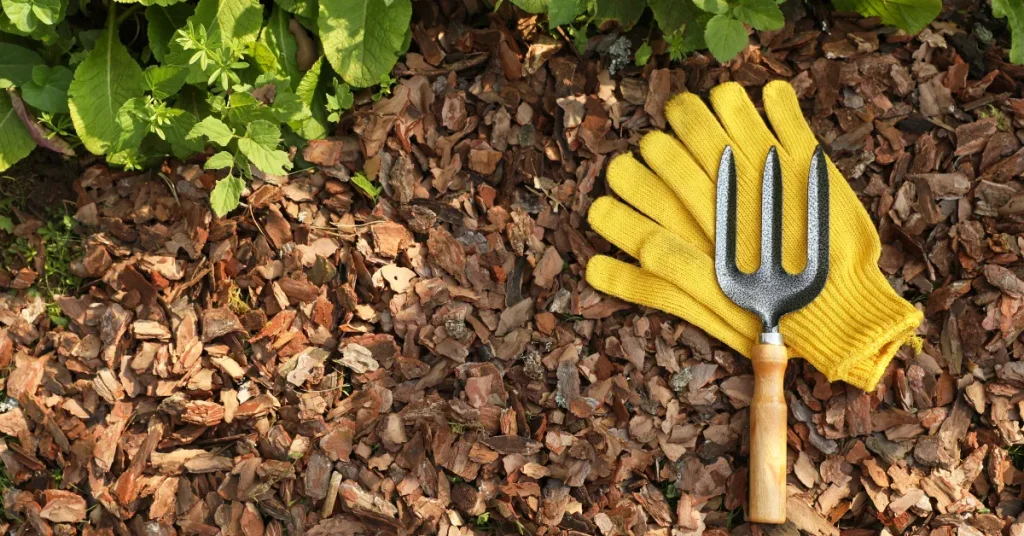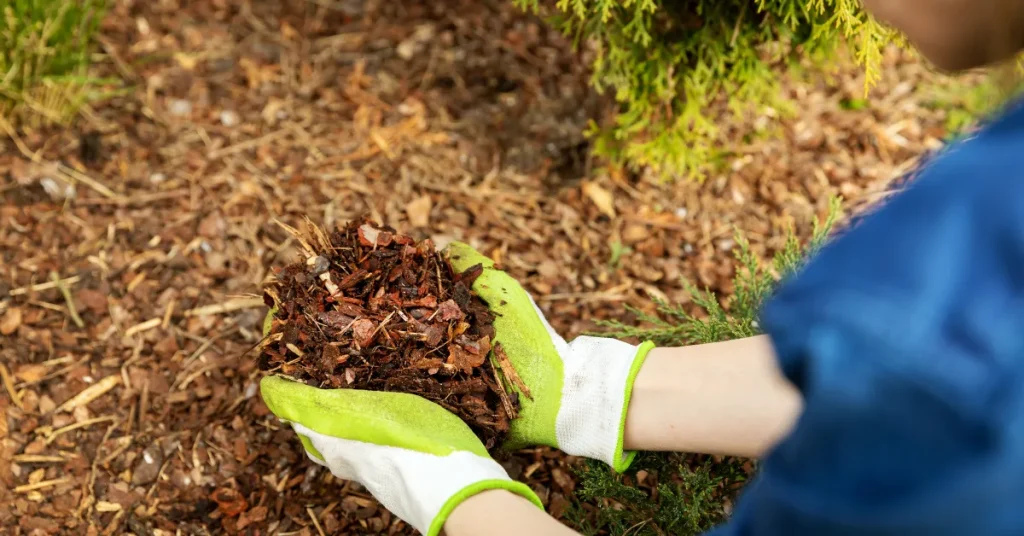Mulch should generally be laid 2 to 4 inches thick for optimal results. Exceeding 4 inches can harm plant roots and limit oxygen.
Applying mulch to garden beds and around trees serves multiple purposes, from suppressing weeds to retaining soil moisture and regulating temperature.
The correct thickness ensures a balance between conserving water and preventing rot or disease by allowing the soil to breathe.
Gardening enthusiasts agree that a well-mulched garden has fewer weeds, more consistent soil temperatures, and better moisture retention, leading to healthier plants.
Choosing organic materials like wood chips or straw can also enrich the soil as they decompose over time.
Properly mulched landscapes not only thrive but also present a tidy, appealing appearance that can enhance the overall aesthetic of outdoor spaces.
Remember to keep mulch away from direct contact with plant stems and tree trunks to avoid rot and pest issues.

The Importance Of Mulch Thickness
Getting mulch thickness right is crucial in gardening. Too little or too much can affect plant health. Ideal mulch depth depends on the mulch type and the plants. This guide explores benefits and risks of mulch application at different depths.
Benefits Of Proper Mulch Application
- Retains soil moisture: A layer of mulch reduces water evaporation from soil.
- Suppresses weeds: Thick enough to block sunlight, mulch keeps weeds from germinating.
- Insulates soil: Mulch acts as a blanket, keeping soil temperature stable.
- Improves fertility: As organic mulches decompose, they enhance soil nutrients.
- Reduces erosion: Mulch helps prevent soil erosion from wind and water.
Risks Of Incorrect Mulch Depth
- Root rot: Mulch piled too high against stems traps moisture, harming plants.
- Pest habitat: Overly thick mulch can become a home for rodents and insects.
- Starves plants of oxygen: Excessive mulch can limit soil oxygen, hindering root growth.
- Delayed warming: Too much mulch can keep soil too cool, delaying plant growth in spring.
- Nutrient imbalance: If not applied correctly, mulch can lock away nitrogen, affecting plant health.
Types Of Mulch And Their Ideal Depths
Laying the right amount of mulch is key to a healthy, weed-free garden. Understanding which type of mulch to use and how thick to apply it can mean the difference between nurturing your plants and suffocating them.
Let’s explore how deep mulch should be for various garden scenarios.
Organic Mulches: Wood Chips, Bark, And Straw
Organic mulches break down over time, improving soil health. But thickness matters.
- Wood Chips: Apply a 3 to 4-inch layer. Too thick can limit oxygen.
- Bark Mulch: Use 2 to 3 inches for perennials. For trees, a 3 to 4-inch layer works.
- Straw: A 6 to 8-inch layer is ideal. It compacts over time, so start thicker.
Inorganic Mulches: Rubber, Rocks, And Fabrics
Inorganic mulches don’t break down, making thickness crucial for plant health and weed control.
- Rubber Mulch: A 2-inch layer suffices, as rubber doesn’t decompose.
- Rocks: Use a 2 to 3-inch layer. Check for plant type compatibility.
- Landscape Fabrics: These are laid flat, covered by another mulch type, usually an organic one.
Remember, proper depth encourages moisture retention and insulation, while preventing weed growth. Always clear old mulch before reapplying to maintain the correct depth.
Measuring Mulch: Tools And Techniques

Proper mulch depth ensures healthy soil and plants.
The Ruler Method
Let’s begin with a simple tool: the ruler.
Using a ruler proves to be a straightforward approach.
- Lay the ruler vertically against the mulch.
- Mark the depth at the top layer.
- Check multiple areas to ensure even coverage.
Depth Probes For Accuracy
Now, let’s talk precision.
Depth probes provide precise measurements.
They are specialists in gauging mulch thickness.
- Insert the probe into the mulch.
- Stop when the probe hits soil.
- Read the depth off the calibrated shaft.
Remember, 2 to 4 inches is the magic range.
Too thick, and soil misses vital moisture.
| Area | Recommended Depth |
| Flower Beds | 2-3 inches |
| Vegetable Gardens | 2-4 inches |
| Pathways | 3-4 inches |
Mulch Depth For Plant Health
Choosing the right mulch depth is crucial for plant health. Too little and plants won’t reap the benefits. Too much and you might stifle growth and invite pests. The perfect balance supports root systems, regulates temperature, and preserves moisture. Let’s dive into the specifics.
Root Oxygenation And Soil Life
Plants need oxygen at their roots to thrive. The right mulch depth ensures soil remains loose and allows air to reach the roots. A layer of 2-4 inches is ideal. This depth supports microorganisms in the soil that benefit plant health.
- Avoid mulch against plant bases to prevent rot.
- A 2-4 inch layer enhances aeration without suffocating roots.
- Mulch depth over 4 inches can compact soil and reduce oxygen.
Moisture Retention And Evaporation Control
The right mulch depth helps soil keep the perfect moisture level. Plants stay hydrated, with less watering needed.
Follow these guidelines:
| Plant Type | Mulch Depth |
| Vegetable Gardens | 2-3 inches |
| Flower Beds | 2-4 inches |
| Trees & Shrubs | 3-4 inches |
Modify depth based on soil type:
- Sandy soils benefit from a thicker layer to retain moisture.
- Clay soils need a thinner layer for better evaporation.
Seasonal Considerations In Mulch Application

Mulching is more than just a garden task; it’s a strategic decision. Different seasons command varied mulch thickness for optimum plant health. Let’s explore how seasonality affects this crucial layer for your garden.
Adjusting Mulch Depth For Winter Protection
Winter calls for a thicker blanket for your plants. Mulch acts as an insulator. It keeps soil temperatures steady. Aim for a depth of 3 to 4 inches. This depth protects roots from the cold.
- Choose the right material: Straw or shredded leaves work well.
- Avoid compaction: Loose, airy layers trap heat better.
- Apply before freeze: Lay mulch after the first hard frost.
By doing so, the ground remains warmer. This allows for prolonged root activity.
Summer Mulching: Thickness For Heat And Drought
Summer mulching helps conserve water. It reduces evaporation and keeps roots cool. A 2 to 3-inch layer is typically sufficient. Be mindful not to overdo it, as excess mulch can suffocate roots.
- Organic options: Wood chips or clippings shield soil from sun.
- Moisture retention: A proper layer limits the need for frequent watering.
- Prevent pests: Keep mulch away from plant bases to deter bugs.
In hotter regions, consider lighter-colored mulches. They reflect sunlight and further reduce soil temperature.
Expert Tips For Mulching
Mastering the art of mulching is essential for the health of your garden. Not only does a proper layer of mulch conserve soil moisture and regulate temperature, but it can also ward off weeds.
Follow these expert tips to ensure your mulching technique is effective and beneficial to your plants.
Applying Mulch Around Trees And Shrubs
- Clear the area of weeds and debris before mulching.
- Apply a 2 to 4-inch layer of mulch around trees and shrubs.
- Keep mulch away from the base to prevent rot.
- Create a trough around the drip line to ensure effective water absorption.
Avoiding Common Mulching Mistakes
| Mistake | Tip to Avoid |
| Piling mulch against plant stems or tree trunks. | Maintain a mulch-free space around the base. |
| Using too much or too little mulch. | Stick to a 3-inch ideal layer for most gardens. |
| Ignoring mulch material type. | Choose the right type according to your plant’s needs. |
| Forgetting to refresh or replace mulch. | Add fresh mulch annually or as needed. |
By implementing these strategies with care, your garden will thrive. Applying mulch correctly around trees and shrubs is crucial, yet simple.
Avoiding common mulching mistakes will save you time and protect your plants. Follow these steps for an optimal mulched garden.
FAQs About How Thick To Lay Mulch
Is 2 Inches Of Mulch Enough?
Yes, 2 inches of mulch is generally sufficient to suppress weeds and retain soil moisture. Ensure an even layer for optimal results.
What Is The Best Thickness For Mulch?
The ideal mulch thickness is typically 2 to 4 inches. Exceeding this can harm plant roots and hinder water penetration.
Is 3 Inches Of Mulch Too Much?
Three inches of mulch is typically ideal, as it suffices to suppress weeds and retain soil moisture without risking harm to plants.
How Thick Of Mulch Do I Need?
Aim for a mulch layer that is 2-3 inches thick to effectively suppress weeds and maintain soil moisture. Avoid exceeding this thickness to prevent root rot and allow water and air to reach the soil.
Conclusion
As you tackle your gardening projects, remember the mulch thickness rule: 2-4 inches. Achieving that sweet spot ensures healthy plants and fewer weeds.
A well-mulched garden retains moisture, warding off drought stress. So, measure with care, and spread thoughtfully. Your garden’s vitality depends on it.
Stay grounded and mulch on!
Resources:
1. https://extension.psu.edu/mulching-landscape-trees
